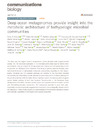Please use this identifier to cite or link to this item:
https://accedacris.ulpgc.es/jspui/handle/10553/107460
| Title: | Deep ocean metagenomes provide insight into the metabolic architecture of bathypelagic microbial communities | Authors: | Acinas, Silvia G. Sánchez, Pablo Salazar, Guillem Cornejo-Castillo, Francisco M. Sebastián Caumel, Marta Logares, Ramiro Royo-Llonch, Marta Paoli, Lucas Sunagawa, Shinichi Hingamp, Pascal Ogata, Hiroyuki Lima-Mendez, Gipsi Roux, Simon González, José M. Arrieta, Jesús M. Alam, Intikhab S. Kamau, Allan Bowler, Chris Raes, Jeroen Pesant, Stéphane Bork, Peer Agustí, Susana Gojobori, Takashi Vaqué, Dolors Sullivan, Matthew B. Pedrós-Alió, Carlos Massana, Ramon Duarte, Carlos M. Gasol, Josep M. |
UNESCO Clasification: | 2510 Oceanografía | Keywords: | Environmental microbiology Microbial biooceanography Microbial ecology |
Issue Date: | 2021 | Project: | Expedición de circunnavegación MALASPINA 2010: Cambio global y exploración del océano global | Journal: | Communications Biology | Abstract: | The deep sea, the largest ocean’s compartment, drives planetary-scale biogeochemical cycling. Yet, the functional exploration of its microbial communities lags far behind other environments. Here we analyze 58 metagenomes from tropical and subtropical deep oceans to generate the Malaspina Gene Database. Free-living or particle-attached lifestyles drive functional differences in bathypelagic prokaryotic communities, regardless of their biogeography. Ammonia and CO oxidation pathways are enriched in the free-living microbial communities and dissimilatory nitrate reduction to ammonium and H2 oxidation pathways in the particle-attached, while the Calvin Benson-Bassham cycle is the most prevalent inorganic carbon fixation pathway in both size fractions. Reconstruction of the Malaspina Deep Metagenome-Assembled Genomes reveals unique non-cyanobacterial diazotrophic bacteria and chemolithoautotrophic prokaryotes. The widespread potential to grow both autotrophically and heterotrophically suggests that mixotrophy is an ecologically relevant trait in the deep ocean. These results expand our understanding of the functional microbial structure and metabolic capabilities of the largest Earth aquatic ecosystem. | URI: | https://accedacris.ulpgc.es/handle/10553/107460 | ISSN: | 2399-3642 | DOI: | 10.1038/s42003-021-02112-2 | Source: | Communications Biology [EISSN 2399-3642], v. 4 (1), 604, (Diciembre 2021) |
| Appears in Collections: | Artículos |
SCOPUSTM
Citations
119
checked on Jun 8, 2025
WEB OF SCIENCETM
Citations
119
checked on Jun 8, 2025
Page view(s)
120
checked on Feb 9, 2025
Download(s)
100
checked on Feb 9, 2025
Google ScholarTM
Check
Altmetric
Share
Export metadata
Items in accedaCRIS are protected by copyright, with all rights reserved, unless otherwise indicated.
